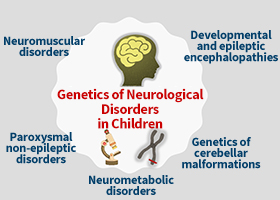Genetics of Neurological Disorders in Children
A special issue of Brain Sciences (ISSN 2076-3425). This special issue belongs to the section "Molecular and Cellular Neuroscience".
Deadline for manuscript submissions: closed (10 July 2021) | Viewed by 20170

Special Issue Editor
Interests: prematurity and neurodevelopmental trajectories; epileptic encephalopathies; paroxysmal nonepileptic disorders in childhood; migraine; neurometabolic diseases; Rett and Rett-like syndrome
Special Issues, Collections and Topics in MDPI journals
Special Issue Information
Dear Colleagues,
We are pleased to invite you to contribute to this Special Issue of Brain Sciences dedicated to the genetics of neurological disorders in children.
Neurological diseases in childhood often stem from genetic causes. Epileptic and developmental encephalopathies, paroxysmal nonepileptic disorders, malformations of the central nervous system, neurometabolic diseases, neuromuscular disorders, and many others make up the wide constellation of neurogenetic diseases in developing age. Fundamental advances have been reached throughout the last years, leading to a marked improvement in molecular and/or cytogenetic investigation approaches: from karyotype and linkage analyses, we recently gained new-generation techniques, such as exome- or genome-sequencing, that allowed us to identify disease-causing mutations in a high percentage of patients. This Special Issue aims to retrace the path of genetic approaches to neurological disorders in children, from complex diagnostics to the latest innovative technologies. We will be pleased to receive your valuable manuscripts in the form of reviews and articles.
Prof. Dr. Gabriella Di Rosa
Guest Editor
Manuscript Submission Information
Manuscripts should be submitted online at www.mdpi.com by registering and logging in to this website. Once you are registered, click here to go to the submission form. Manuscripts can be submitted until the deadline. All submissions that pass pre-check are peer-reviewed. Accepted papers will be published continuously in the journal (as soon as accepted) and will be listed together on the special issue website. Research articles, review articles as well as short communications are invited. For planned papers, a title and short abstract (about 100 words) can be sent to the Editorial Office for announcement on this website.
Submitted manuscripts should not have been published previously, nor be under consideration for publication elsewhere (except conference proceedings papers). All manuscripts are thoroughly refereed through a single-blind peer-review process. A guide for authors and other relevant information for submission of manuscripts is available on the Instructions for Authors page. Brain Sciences is an international peer-reviewed open access monthly journal published by MDPI.
Please visit the Instructions for Authors page before submitting a manuscript. The Article Processing Charge (APC) for publication in this open access journal is 2200 CHF (Swiss Francs). Submitted papers should be well formatted and use good English. Authors may use MDPI's English editing service prior to publication or during author revisions.
Keywords
- Developmental and epileptic encephalopathies
- Paroxysmal non-epileptic disorders
- Neurometabolic disorders
- Neuromuscular disorders
- Genetics of cerebellar malformations
Benefits of Publishing in a Special Issue
- Ease of navigation: Grouping papers by topic helps scholars navigate broad scope journals more efficiently.
- Greater discoverability: Special Issues support the reach and impact of scientific research. Articles in Special Issues are more discoverable and cited more frequently.
- Expansion of research network: Special Issues facilitate connections among authors, fostering scientific collaborations.
- External promotion: Articles in Special Issues are often promoted through the journal's social media, increasing their visibility.
- e-Book format: Special Issues with more than 10 articles can be published as dedicated e-books, ensuring wide and rapid dissemination.
Further information on MDPI's Special Issue polices can be found here.






